Our Asian Adventure: Singapore, Part 1 - don’t chew gum, maybe try the durian, and do enjoy lots of that amazing Hainanese coffee
- debbiemanderson1
- Apr 3
- 13 min read
Updated: Apr 4

We arrived in Singapore after spending a week smitten by the culture and humbleness of Cambodia. Singapore might be less than two hours’ plane flight from Phnom Penh, but it is worlds away in all ways. First, some ‘housekeeping’ about Singapore, and then I'll get to our first two days of discovery.
If you described Singapore as an island or a city or a country, you’d be right. It covers an area of about 284 square miles, and the population of this island/city/country is about six million. If we thought Kuala Lumpur or Cambodia were hot and humid, Singapore sits at one degree latitude or 137 kms north of the equator. That means the air and your T-shirt are damp with humidity, in addition to the almost daily, sometimes almost torrential, rainfall (which does provide a few minutes of respite from the heat - and it’s a warm rain that locals don’t even seem to notice).
About that heat, the good news is that despite generally high prices, there are drink machines everywhere with really good and really cheap drinks like chrysanthemum tea (so good). This was about 11:00 one morning. You can see the perspiration marks on his T-shirt. The chrysanthemum tea came in mighty handy.

All of that rain and humidity and heat make Singapore one giant greenhouse. It is probably the greenest and most lush city we’ve visited.
On first glance, Singapore looks like utopia with it’s fancy cars, high-end (and I mean high-end) boutiques, prevalence of designer shopping malls, teenagers flaunting only top-name clothes and bags, and endless highrises (we thought Kuala Lumpur had a lot of highrises - nothing like Singapore). Add in the precise schedules, immaculate streets, groomed parks, and rules (lots of rules) that prevent everything from littering to importing or selling chewing gum, and it seems like perfection, almost too good to be true. And being one of the most expensive cities in the world to live in, how can everyone keep up the pace? Is there an inequality that we can't see? I don't know, but it’s a good topic to research. (A brief article to start with that hints that all might not be perfect in the state of Singapore is ‘Crazy Rich Singapore . . Yes, and No’ by Saubhik Chakrabarti in timesofindia.indiatimes.com)

Yes, Singapore is an expensive city to live in or visit but knowing a couple of ‘tricks’ helps. Aside from using public transport and Grab taxis, the main strategy to cut back costs is to visit what are called “hawker stalls” for food. Hawker stalls are individual food venders usually part of a larger hawker centre offering affordable traditional food. They originated in Singapore in the 1800’s when migrant workers would sell food on streets or at markets. Now, in addition to outdoor hawker centres, many are covered; and many shopping malls have set up their own hawker courts. The variety and quality are amazing, at a much lesser price than formal restaurants. We ate almost every meal at some type of hawker stall.
Now, if you are addicted to coffee, that’s where the next cost-saving trick comes in, but I’ll save that for a bit later.
We spent four full days in Singapore, and I am glad we had the experience. Although I personally prefer the contrasts and ambience and ‘layers’ of less ‘perfect’ countries, this is a great city in which to simply enjoy, well, a great city.
We stayed in a super hotel, the Royal Plaza on Scott’s Road, and this was a good location, away from downtown but close to transport and close enough for a hearty walk to the central area. The hotel has a signature staircase with a chandelier that resembles the Phalaenopsis orchid with gold and crimson colours. With people visiting from all over and with Singapore being a multi-ethnic city, the hotel had to cater to many tastes for their breakfast buffet. It was far pricier than our Cambodia hotels but nowhere near the price of some we checked in Singapore.


Singapore is easy to navigate by Grab (their version of Uber), hop on/hop off bus, or even by foot - all the main sights could be within walking distance, but watch out for that heat. Take lots of breaks in air conditioning such as cafes, stores, or museums and drink lots of liquids. I imagine the metro and public transit systems are simple and straightforward, but we did not use either.
Singapore is divided into several areas that are of interest to travellers. On our first two days, we rode the hop on/hop off tourist bus to give us a general overview of the city and to take us to different areas we wanted to visit at some point. There might be quicker ways to travel, but hop on/hop off buses are such a great way to become familiar with a city. The map below shows the routes. Our hotel was in the upper left hand corner on Scott’s Road.

On our first day we took the yellow route downtown to the central and civic area, marina, and Gardens By The Bay which are major destinations in Singapore. These sights are all within walking distance of each other.
We first stopped at the iconic Raffles Hotel on the edge of downtown. You have heard of Singapore Slings and maybe even tried one or two in your lifetime? Well, a Raffles Hotel Long Bar bartender is said to have created the Singapore Sling as a drink for women because, in the early 1900’s, it was not appropriate for a women to have an alcohol drink in hand. The Singapore Sling looked like a fruity punch and immediately became a hit with the women. The origin (and the recipe) are both disputed, however. In any event, the drink remains tied to the Raffles Hotel. Today, you can have a Singapore Sling at Raffles for ‘only’ about $37 Canadian. No, we did not imbibe in one of the almost 1,000 served daily by the hotel. (The hotel is planting one tree in a rainforest for every 25 Singapore Slings sold to help the ecosystem.) The hotel, itself, dates to 1887 and boasts of “timeless elegance” that has entertained royalty, dignitaries, and actors. The hotel is named after Sir Thomas Stamford Raffles, the founder of modern Singapore. By the way, if you do have a drink in the Long Bar, it’s about the only place that littering is legal in Singapore as you can throw peanut shells on the floor. Being that old and with such claims to fame, the Raffles Hotel has seen a lot that you might want to research. It’s been featured in many films.

Up the stairs to the Long Bar:
Just one example of the glamour that is the Raffles Hotel:

Kitty-corner, as we say, to the Raffles is Chijmes, formerly known as the Convent of the Holy Infant Jesus that was once a home for orphaned children and women. It is a beautiful stately building dating to the mid-1800’s that is now used as a hall and wedding venue (do you remember the wedding scene from Crazy Rich Asians?). The area surrounding the venue is now an entertainment area with cafes and bars.

The Honey Buzzard statues were particularly stunning against the white facade of the convent. You can read about them and the story of the convent below.



St. Andrew’s Cathedral is an Anglican Cathedral that sits right in the middle of downtown. The current building was built between 1856 and 1861. Interestingly, the church was built by Indian convict labourers which was a common practice in early Singapore. The architecture is said to have been inspired from a 13th century church in England. The blue and white interior was stunning.


Our next stop to view from outside was the National Gallery Singapore, an art and culture museum in the former Supreme Court. It was the last classical building to be built in Singapore. The building complex also includes Singapore’s old city hall.


The Mother and Child statue was created by Dr. Ng Eng Teng, the “Grandfather of Singapore Sculpture”, reflecting caring and love and humanity. The sculpture was relocated to the National Gallery from a park.
In the large Padang Park in front of the National Gallery, a youth fastball tournament was in progress. The park is a national monument and, in addition to playing fields, it is the site for concerts and parades. It also contains the Singapore War Cenotaph.


At the end of Padang Park sits the beautiful old Victoria Theatre. Walk around to the riverside for the best view. The oldest part was completed in 1862 and the rest was completed in 1909. It was completely renovated from 2010 to 2014. The theatre building’s first life was as Singapore’s town hall. The theatre has seen many significant events such as elections, war crime trials, and a hospital for victims of bombing raids.

The Esplanade Theatre on the Bay sits right behind the Padang Park. You can’t miss it because it is shaped like a giant thorny durian fruit. More about the theatre in a bit.
We have to talk about durian at some time, so now is as good as ever. We were told in Kuala Lumpur that many locals love durian, especially children. I suspect you have to acquire the taste and adapt to the smell. The smell is so bad, the fruit is often banned in hotel rooms. For a few laughs, do an on line search for ‘the smell of durian’. A few compare it to sulphur, sewage, dirty socks . . . and a combination thereof. A great article to read is by Ken Garrett: “Durian: The King of Fruits . . . . “ at quillandpad.com. We had to try just a small sample of durian-flavoured chocolate and immediately spit it out. However, there are durian flavoured desserts, drinks, and sweets. If you are in Southeast Asia, you might like to try it - or not.

Now, more about the Esplanade Theatre on the Bay. It is also considered a must-see in Singapore for it’s architecture and setting. The theatre consists of two concert halls or theatres, one seating 1,600 and one seating 2,000. The structure also contains a mall and smaller recital rooms. Outside is an outdoors stage looking over the bay. About that shape . . . it was never intended to look like durian fruit. The domes were made to accommodate 7,000 aluminum sunshades that cover the glass structure. Regardless, some complain that it looks like “two copulating aardvarks” - that’s quite the visual. But if a local says they’ll meet you at “the big durians”, go to the Esplanade Theatre.

Just around Marina Bay is the Singapore Flyer, marketed as an observation wheel from which to see the city. It has 28 air conditioned cabins that accommodate 28 persons each. It stands 56 metres high and was once the world’s tallest ferris wheel. It has also been featured in movies, music videos, and the Amazing Race. You can’t miss it towering over the bay.
A view from across the bay:

Just a bit further around the bay and across the Helix Bridge is the beautiful lotus-shaped Art Science Museum that sits within the grounds of the Marina Bay Sands resort. The museum has a round base with 10 extensions in the shape of a flower. It would be beautiful at night as each ‘petal’ has illuminating skylights.

The Helix Bridge:

If the Raffles Hotel was old-world opulence, the Marina Bay Sands Resort is modern and ostentatious. The complex includes three towers, 1,850 hotel rooms, a 120,000 square meter convention centre, and a 73,000 square meter upscale shopping mall, casino, and restaurants of all types and price levels. The three towers are topped by the Sands Skypark, a skywalk that is 340 metres long and which includes a 150 metre infinity swimming pool overhanging the north tower. Two of my travelling buddies chose to ascend to the Skypark. I’m sure Bev will post some photos in her blog, A Long and Winding Journey, if you’d like to check it out.
The Marina Bay Sands Resort with the Art Science Museum in the foreground:

The lobby is full of unique architectural angles:

We loved this children’s’ area in the mall. There are little ‘stations’ set around the Digital Lit Canvas in the floor. Children (and adults) can create designs and then have them illuminated in the lit space. Children run and jump on the circle to see the formations change.

Even the walkway to the outside was designed . . .
The walkway takes you over the lovely Dragonfly Bridge to one of Singapore’s main attractions, The Gardens By The Bay. The garden area covers 260 acres and can be entered by three main gates. When designing the garden, the aim was to make Singapore into “a city in a garden” with the garden being the prime urban recreation area. It has been named Trip Advisor’s eighth best attraction in the world. There are two giant conservatories, the Flower Dome and the Cloud Forest. In 2015, the Flower Dome was the largest greenhouse in the world while the Cloud Forest replicates tropical mountain regions. The park is divided into three main sections, Central, East, and South which are further divided into theme gardens such as wetlands, heritage gardens such as Chinese and Indian, and children’s garden. You could spend days exploring this magnificent park and would probably notice something different each time.
The Gardens By The Bay are a wonderful mixture of greenery and statues. Here are some of my favourites, but there are photo-ops everywhere.




One of the conservatories:

One of the highlights of the Gardens By The Bay is the Supertree grove, 18 tree-like formations that are covered in a variety of plants, the tallest ‘tree’ reaching 50 metres. There is a skywalk between the two tallest. The structures are actually important to the park’s well-being as they mimic the natural function of real trees such as providing shade and cooling. You might want to read up online about these amazing Supertrees. They are a lot more than just a pretty face.


We returned to the gardens one evening later in our stay for the nightly light show which plays at 7:45 and 8:45. It was magical and well worth the wait as the lights on the Supertrees danced to traditional waltz music against the dark sky. So beautiful. So many photos.
The Gardens By The Bay even have their own hawker centre, Satay By The Bay, where we ate before the light and music show.
The yellow route hop on/hop off bus stopped within two blocks of our hotel, passing the Singapore Botanic Gardens. The Gardens are a UNESCO World Heritage Site and named as one of Asia's top park attractions. We did not vist, but the gardens must be fantastic given that the entire city of Singapore is a wonderful garden in itself.
The red route of the hop on/hop off bus took us to two authentic and traditional areas of Singapore, Little India/Kampong Glam and Chinatown (where we were in for a big surprise - a couple, actually).
There’s quite a history to Little India which sits north of the downtown. In the mid-19th century, herders settled and raised cows in this area, with Indian labour as help. The area flourished, and the government opened brick kilns and lime pits, again with Indian labour. The adjacent Kampong Glam, likewise, has a lengthy history dating to the early 1800’s and is known as the “Muslim quarter” of the city. We did not spend a lot of time in either area, but both were an enjoyable respite from the energy of the big city only blocks away.
Little India, especially, gives off an authentic Indian village vibe. We strolled down one of the main streets, Serangoon Road, considered the heart of Little India, and onto some side streets. Small family-owned shops sell everything from clothes to jewellery to housewares to spices. The smells were amazing, and we regretted that it was too early to eat in any one of the many little cafes. Goldsmithing is an important traditional trade here, and one block was lined with gold shops with elaborate jewellery for sale.
Here are some Little India street scenes:
One sweet historical site in Little India is the House of Tan Teng Niah, built in 1900 with a mix of cultural vibes including European columns, Chinese tiles, and Malay wood. It is bright and colourful and has a good story attached. It is the last surviving Chinese house in Little India, dating back to the time when Chinese businessmen operated small businesses alongside the cattle and rattan industries. Tan Teng Niah, who was known as a reputable businessman, owned several factories that used sugarcane to produce sweets.



Another ‘bright and colourful’ structure (but far less humble) in Little India is the Sri Srinivasa Perumal Temple. This is a Hindu temple built for the worship of Vishnu (part of the Hindu trinity), associated with protection. The main gate has five layers of figurines and is so intricate, you would have to study it for a long time to ascertain all the meanings. I have to say that I am lacking knowledge of eastern religions, but the colours and figures and practices are fascinating. Much food was being offered in reverence. The bells on the door were rung by some worshippers as they entered. It is apparently a ritual practice to do away with negativity and to purify the space in preparation for prayer.

This pretty lady posed for her daughter and me:

There is a street mural trail to be followed if you wish in Little India/Kampong Glam. We ran into several without any effort:
We visited only one street in Kampong Glam, said to be a must-visit, Haji Lane. It is packed with independent shops (often young Asian designs or vintage or collectibles), cafes, and bars. There are also plenty of tourists. We happened upon a well-known jazz bar for lunch.


Although we did not stop to visit, Kampong Glam is home to Singapore's most important mosque, the Sultan Mosque. It is unique as it was built from contributions fom the public; even glass bottles donated by the poor were used in the construction. I regret not stopping for a better view.

Singapore's Chinatown sits south of the downtown, and the hop on/hop off bus took us right there. In 1822, the founder of modern Singapore, Sir Stamford Raffles, divided the city into indentifiable quarters. At the time, Chinese labourers lived behind warehouses south of the downtown. Soon Chinese temples and 'clan' groups (people with common backgrounds) developed.
Indian soldiers, traders, and labourers had also settled in the area. They built Singapore's first Hindu temple, Sri Mariamman Temple, in what is now Chinatown. It is a National Monument.

The Chinatwn Street Market is a popular shopping and cultural street closed to vehicles and good for a stroll. It is packed with souvenir/trinket stalls, shops, and restaurants. It is also home to the Chinatown Heritage Centre which would be good for a visit on a future trip.
Like I said, it is hot and humid in Singapore and, at this point, we were feeling a little worn. We needed a break, but all the modern coffee shops were packed with people on a Sunday afternoon. Then we made a discovery that changed my life in Singapore - well, that's being a little dramatic. We fell upon Nanyang Old Coffee, and we experienced our first taste of Hainanese coffee made from Robusta beans roasted with butter and sugar, brewed in a small pot, strained through a 'sock', and poured from a greater height than regular coffee. It's the best coffee, ever. It's way cheaper than coffee in modern cafes, too. I'll tell you about a couple of other traditional Hainanese coffee houses in my blog, 'Singapore, Part 2'
Our next surprise, now that we were hydrated and rested, was falling upon part of Chinatown's annual Five Footway Festival which showcases and promotes Chinese culture and traditions. We enjoyed the street fair with information, traditional games, crafts, and music. ('Five Footway' refers to the covered pedestrian walkway along the front of 'shophouses' providing shelter from rain and sun. A typical shophouse would have the shop downstairs and the living quarters upstairs extending outwards, the overhang providing the covered walkway.)

That ended our first two days in Singapore using the hop on/hop off bus to discover some 'must-see' quarters. What a great two days!
Please come back for 'Singapore, Part 2' where I talk about a lush historic park, some joyful statues, a funky bridge, some prime real estate and, of course, more coffee.
Thanks for reading.










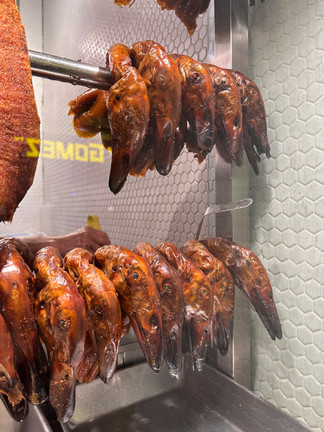













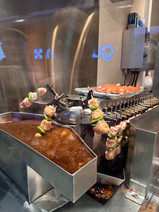













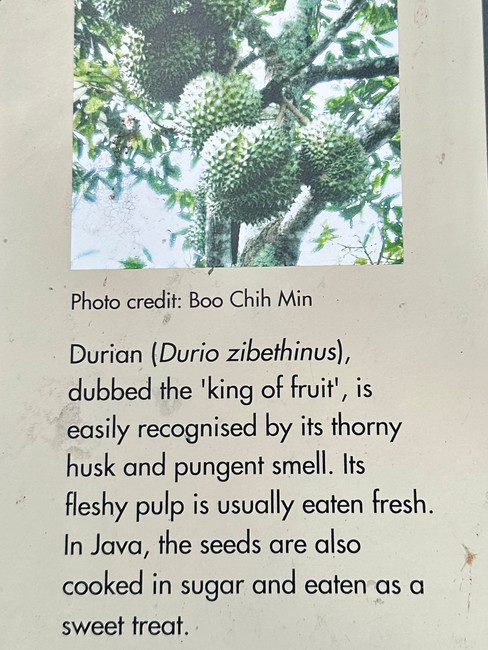















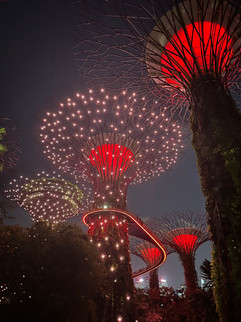





























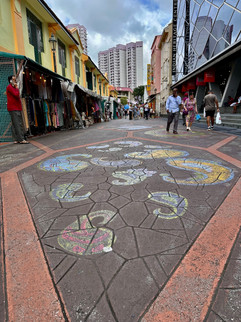









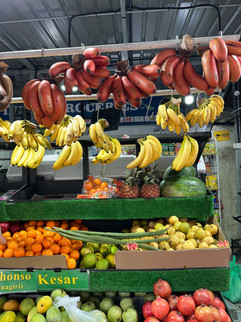





































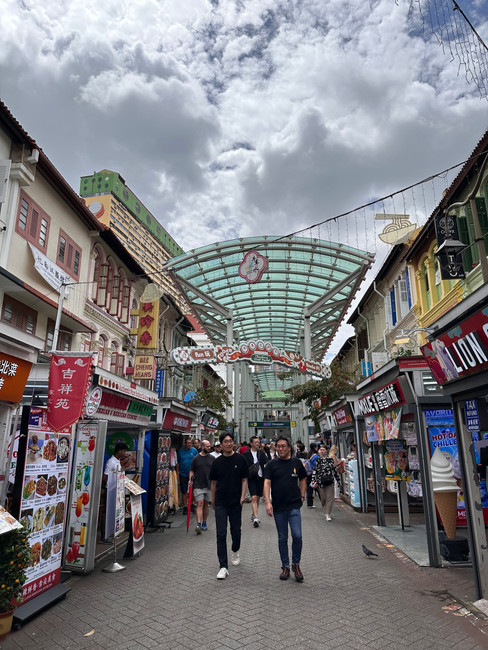

































Comments